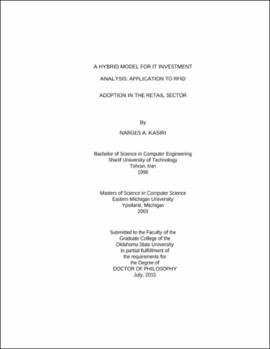| dc.contributor.advisor | Sharda, Ramesh | |
| dc.contributor.author | Kasiri, Narges A. | |
| dc.date.accessioned | 2013-11-26T08:20:57Z | |
| dc.date.available | 2013-11-26T08:20:57Z | |
| dc.date.issued | 2010-07 | |
| dc.identifier.uri | https://hdl.handle.net/11244/6433 | |
| dc.description.abstract | Scope and Method of Study: One of the major obstacles in Information Technology (IT) adoption is its return on investment analysis. IT benefits in organizations are hard to measure and are usually realized over time. System dynamics approach has been used in IT literature to identify the impact of IT on business processes. Given benefits of any IT system in organizations, however, there is a high degree of uncertainty in achieving such benefits. Managerial flexibility in decision making process of implementing a new IT helps managers to overcome this uncertainty over time. Traditional cost benefit analysis such as NPV that is typically used to value any technology is unable to value managerial flexibilities while real options theory offers a model that can value a new investment as uncertainties about the system decreases over time. In this dissertation, we are proposing a new hybrid model for IT return on investment (ROI) that combines system dynamics and real options as two major techniques in economics of IT. This robust hybrid model takes advantages of both techniques while overcoming their weaknesses. We propose a systems dynamic solution to simulate the way an IT influences and improves an organization to be able to estimate the parameters used in the real options model. The hybrid model is used to find the best time for investing in item-level RFID in the retail sector. | |
| dc.description.abstract | Findings and Conclusions: The results of return on investment analysis on item-level investment show that the variable cost of investment that is the tag prices dominates the return on investment. Other factors such as product unit price and consequently type of retail stores are important as well. The system dynamics simulation provided some major parameters of the real options model such as the expected payoffs and volatility of the expected payoffs that were hard to find in the literature. | |
| dc.format | application/pdf | |
| dc.language | en_US | |
| dc.rights | Copyright is held by the author who has granted the Oklahoma State University Library the non-exclusive right to share this material in its institutional repository. Contact Digital Library Services at lib-dls@okstate.edu or 405-744-9161 for the permission policy on the use, reproduction or distribution of this material. | |
| dc.title | Hybrid model for IT investment analysis: Application to RFID adoption in the retail sector | |
| dc.contributor.committeeMember | Kletke, Marilyn | |
| dc.contributor.committeeMember | Wilson, Rick | |
| dc.contributor.committeeMember | Arnold, Todd | |
| dc.contributor.committeeMember | Hardgrave, Bill | |
| osu.filename | Kasiri_okstate_0664D_11033.pdf | |
| osu.accesstype | Open Access | |
| dc.type.genre | Dissertation | |
| dc.type.material | Text | |
| dc.subject.keywords | delphi study | |
| dc.subject.keywords | economics of it | |
| dc.subject.keywords | real options | |
| dc.subject.keywords | system dynamics | |
| thesis.degree.discipline | Business Administration | |
| thesis.degree.grantor | Oklahoma State University | |
